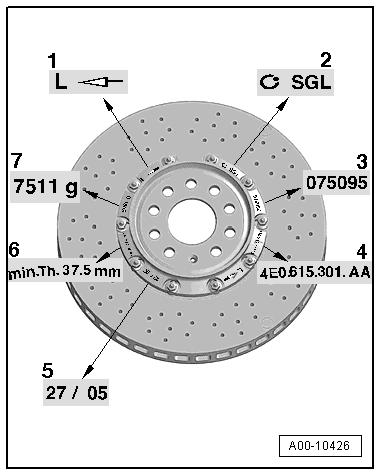A5

| 1 - | Direction of rotation |
| 2 - | Supplier |
| 3 - | Serial production number of brake disc |
| 4 - | Audi part number |
 Note
Note| The Audi part number of the brake disc is an example and can vary depending on the vehicle type and model |
| 5 - | Production date of brake disc |
| 6 - | Permissible minimum thickness of brake disc |
 Note
Note| The minimum permissible thickness of the brake disc differs depending on the type of vehicle. |
| 7 - | Weight of new brake disc with brake disc hub |
| Checking area of bolted connection on friction ring and brake disc hub: |
 WARNING
WARNING
|
 Note
Note| The weight of the new brake disc with hub differs depending on the type of vehicle. |
 Note
Note
|
| 1. Wear assessment by checking thickness of brake disc → Chapter | |||
| Thickness of brake discs in permissible range → brake disc OK | |||
| Brake disc thickness in critical range min. Th + 0.2 mm | Value at or below limit | ||
| ↓↓ | ↓↓ | ||
| Further wear assessment on basis of wear indicators | Renew brake disc | ||
| ↓↓ | ---------- | ||
| 3. Wear assessment on basis of wear indicators → Chapter | |||
| None of the six wear indicators fully worn out → brake disc OK | |||
| ---------- | One of the six wear indicators fully worn out | ||
| --------- | ↓↓ | ||
| ---------- | Renew brake disc | ||
|

 Caution
Caution